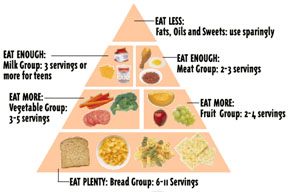 
Prepared by
Melissa Brener, MS
Most nutrition professionals agree that the average person
gets plenty of vitamins from their food (especially if they eat a balanced, food guide
pyramid diet) and doesn't need a supplement.
|
|
Click here for the printable (Word) version of the lesson
VITAL VITAMINS
Introduction
Who needs vitamins? Do you need them? How many
should you take? Is one multi-vitamin enough or do you need several different specialty
vitamins? Can you get vitamins only from pills or are there other sources?
 These are
all questions that many people have. There is much controversy over whether the average,
basically healthy person needs vitamin supplements. However, most nutrition professionals
agree that the average person gets plenty of vitamins from their food, especially if they
eat a balanced diet based on the food guide pyramid. Information in newspapers, magazines
and on television can be confusing. The reason for the confusion is that scientists are
quickly discovering new nutrition information, such as a new use for a vitamin. Sometimes,
studies prove that a vitamin doesn't do what people thought it did. While this seems to
make no sense, it is part of the research process. It is the way we learn new things that
will help to keep people healthy. These are
all questions that many people have. There is much controversy over whether the average,
basically healthy person needs vitamin supplements. However, most nutrition professionals
agree that the average person gets plenty of vitamins from their food, especially if they
eat a balanced diet based on the food guide pyramid. Information in newspapers, magazines
and on television can be confusing. The reason for the confusion is that scientists are
quickly discovering new nutrition information, such as a new use for a vitamin. Sometimes,
studies prove that a vitamin doesn't do what people thought it did. While this seems to
make no sense, it is part of the research process. It is the way we learn new things that
will help to keep people healthy.
What You Will Learn
In this lesson, you will learn about the two major types of vitamins, the fat-soluble
and water-soluble. You will learn how each vitamin functions in your body and the symptoms
of deficiency and over-consumption (toxicity). You will also learn which foods are the
best sources of each vitamin and the Recommended Dietary Allowance (RDA) for each.
Finally, this lesson will discuss vitamin supplements - who needs them and who doesn't.
This information will help you plan a healthy diet, including all necessary vitamins and
nutrients.
Food Guide Pyramid
Review
 The Food Guide Pyramid
is a tool developed to teach people the healthiest way to eat. There are six categories
included in the pyramid, and each contains nutrients that are vital to human beings. Each
of the categories contains vitamins. Some contain the same vitamins or more than one kind
of vitamin. However, no food or food group contains all the vitamins or other nutrients
needed to maintain health. Therefore, it is important to eat a variety of foods from all
the pyramid groups each day. The Food Guide Pyramid
is a tool developed to teach people the healthiest way to eat. There are six categories
included in the pyramid, and each contains nutrients that are vital to human beings. Each
of the categories contains vitamins. Some contain the same vitamins or more than one kind
of vitamin. However, no food or food group contains all the vitamins or other nutrients
needed to maintain health. Therefore, it is important to eat a variety of foods from all
the pyramid groups each day.
What Are
Vitamins?
Vitamins are organic substances. This means they contain the element carbon.
Vitamins are required for specific body functions. Certain body functions need one or
more vitamins to make them work. One example is blood clotting. The blood needs vitamin K
to clot. If you have a lack of vitamin K, you may lose too much blood if your skin is
scratched or cut.
Vitamins are needed in small amounts in the diet. Because of this, vitamins (and
minerals) are known as micronutrients. Humans either can't make the vitamin in their
bodies or can't make enough to meet their needs. If people eat a balanced diet, they will
easily get all their vitamins.
There are 13 vitamins that fall into two categories: fat-soluble vitamins and
water-soluble vitamins. Water-soluble vitamins are dissolved by the water in body cells.
Once they are dissolved, they are removed by urine. Fat-soluble vitamins do not dissolve
in water, so it is harder to remove them from the body. If a person consumes too much of a
fat-soluble vitamin, it can become toxic and have negative side effects. It is much harder
to get too much of a water-soluble vitamin.
 Issued in furtherance of Cooperative Extension
work, Acts of Congress of May 8 and June 30, 1914, in cooperation with the United States
Department of Agriculture. The Louisiana Cooperative Extension Service provides equal
opportunities in programs and employment. Information and Graphics on this site are
copyright protected by LSU Agricultural Center's Louisiana Issued in furtherance of Cooperative Extension
work, Acts of Congress of May 8 and June 30, 1914, in cooperation with the United States
Department of Agriculture. The Louisiana Cooperative Extension Service provides equal
opportunities in programs and employment. Information and Graphics on this site are
copyright protected by LSU Agricultural Center's Louisiana
Cooperative Extension Services.
For more information on the EFNEP program, contact EFNEPMail@agcenter.lsu.edu. |